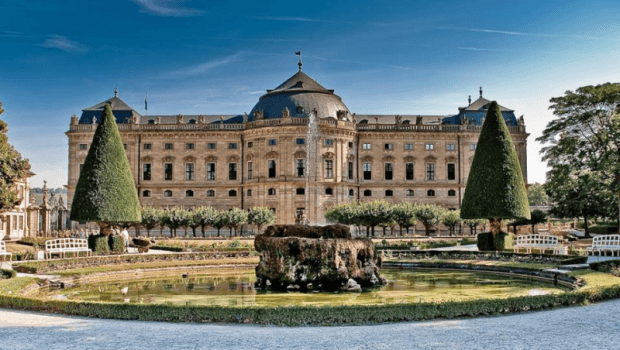
Würzburger Residenz: The Monumental Masterpiece
The Würzburg Residence with its magnificent court gardens and architectural splendor brimming with German history is a must go destination. A previous residence of the Würzburg prince-bishops, it is one of the most beautiful and largest palaces in Germany. The imposing court culture and feudal society of the 18th century are depicted in the building. Within its walls, it holds the testimony of extraordinary artistry, the originality of creativity and unique talent achieved by the result of an ambitious artistic project. It is at the heart of European culture, but it is a product of a joint achievement of many regions such as Paris in France, Venice in Italy, Vienna in Austria and of course Germany. Inspiration came from all over the world from Genoa to Amsterdam. Influence from French chateau architecture, Western architecture, religious and secular architecture, Viennese baroque make the palace an epitome of universality in art. The masterpiece is among UNESCO’s cultural heritage list.
History:
The Royal bishops, Lothar Franz and Friedrich Carl von Schönborn, under their patronage built the Baroque palace in the 18th century. A team of international artists including architects, painters, sculptors as well as stucco-workers were engaged to bring this monument to life. Leading all of these artists was then young and unpopular Balthasar Neumann. He came to be known as a famous German engineer and architect. Unlike the Munich residence which was completed after some five hundred years, the Würzburg was built within about a single generation between 1720 and 1744 and finalized in 1780. The interior decoration was done from 1740 to 1770 and the surrounding landscape with the wonderful gardens was completed between 1765 and 1780. It took about sixty years to complete. Neumann’s infamous staircase with its wondrous unsupported roof was constructed in 1752/53 by the Vatican painter Giovanni Battista Tiepolo. The plans for the magnificent residence were drawn up by the most renowned architects of the time including the Viennese, Lukas von Hildebrandt, and Robert de Cotte. Germain Boffrand gifted woodcarvers and sculptors Johann Wolfgang van der Auvera from Mechelen and Georg Adam Guthmann from Munich brought out the artistic excellence while Italian Antonio Bossi was known as the ornamentation genius of the palace. The architect Maximilian von Welsch of the Elector of Mainz supervised them along with Balthasar Neumann the official architect employed by the patrons.
Structure:
The Palace
The palace consists of four floors with a mezzanine floor above each which provided the servants quarters. The residence holds a vestibule, the Garden Hall, White Hall, Imperial Hall, Staircase, Court Chapel, Southern Imperial Apartments, Memorial Rooms, Tuscany Rooms, Northern Imperial Apartments, State Gallery, Ingelheim Rooms and the Princes’ Hall. The sequence of rooms start with the vestibule and Garden Hall continues through the staircase and White Hall and goes all the way to the Grand Imperial Hall. The fresco in the ceiling represents the four continents- Europe, America, Africa and Asia which are personified as women. It is among the largest frescos to have ever been created with a dimension of 18 x 30 meters. There are other frescos lined up in the hall painted by Tiepolo. The Garden Hall presents a magnificent fresco depicting a banquet of the Greek gods. The White Hall and Imperial Hall in the upper floor contain marble columns, frescos, and intricately designed stucco. A tour of the entire palace takes quite a bit of time because it includes 40 rooms to visit, a rich assortment of paintings, furniture, tapestries, and other artifacts to observe. The Court Chapel can be entered separately from the Southern front yard. It’s incredible artwork of marble structures, vaults, and frescos make up for its small size. Tiepolo painted the side altars that depict the War in Heaven to the north and the Assumption of Mary to the South. The high altar created by Antonio Bossi is made to look like marble. It is an impressive example of religious art. The State Gallery contains 17th and 18th-century art from Venice.
The Garden
The Court garden is a pleasure dome of natural as well as artistic delights. It is located on the edge of the Baroque town fortifications. Its massive walls support and form the border of the eastern palace complex. The court gardener Johann Prokop Mayer was instructed to lay out the garden of the residence. Mayer divided the space into individual gardens. Each division is symmetrically arranged. The irregular shape of the land that rose steeply towards the bastion formed a rococo-style garden. Clipped fruit trees, flower beds, tub plants, espaliers, hedges, and pergolas dotted every inch of the space. Groups of puttos by German sculptor Johann Peter Wagner decorate the terraced garden in the east. The South Garden is rectangular in shape. It is entirely flat in contrast to the east garden which rises in three terraces. Few trees cut into cone shapes encircle the water basin. This façade constitute the center of the southern garden. The round pool has a large monolith made of tuff. A small fountain above it operates in the winter months. The neoclassical sculptures in the garden are copies of the originals made by Johann Peter Wagner. Johann Georg Oegg, the court locksmith, and ornamental metal worker forged the grand iron gates. There is also a kitchen garden which was reconstructed and opened to the public in 2002. New and historical types of fruits and vegetables are laid out in the original pattern of beds and paths. The fruit trees below the orangery are clipped as per historical methods. On the town side, the gardens are in geometrical sections. They are landscape gardens of a 19th-century style.
The Second World War destroyed a large part of this cultural heritage. The skillful vaulting of the rooms survived the devastating fire of 1945 when the palace was harshly affected by aerial bombing on March 16. The ceiling and floors of the Imperial Apartments were destroyed. The furnishings and wall paneling had been taken off beforehand. Hence the rooms were reconstructed. Since 1945 the Residence of Würzburg had undergone continuous restorative measures. The restoration work was completed in 1987, and the Mirror Cabinet has reopened again.
The palace remains open for public viewing from April to October from 9 am to 6 pm and from 10 am to 4:30 pm from November to March. It remains closed on 1st January, Shrove Tuesday, 24th, 25th and 31st December. English speaking guidance is available daily from 11 am to 3 pm.
So, go ahead and plan a trip to this grand palace and enjoy exploring this place with your family and friends.
